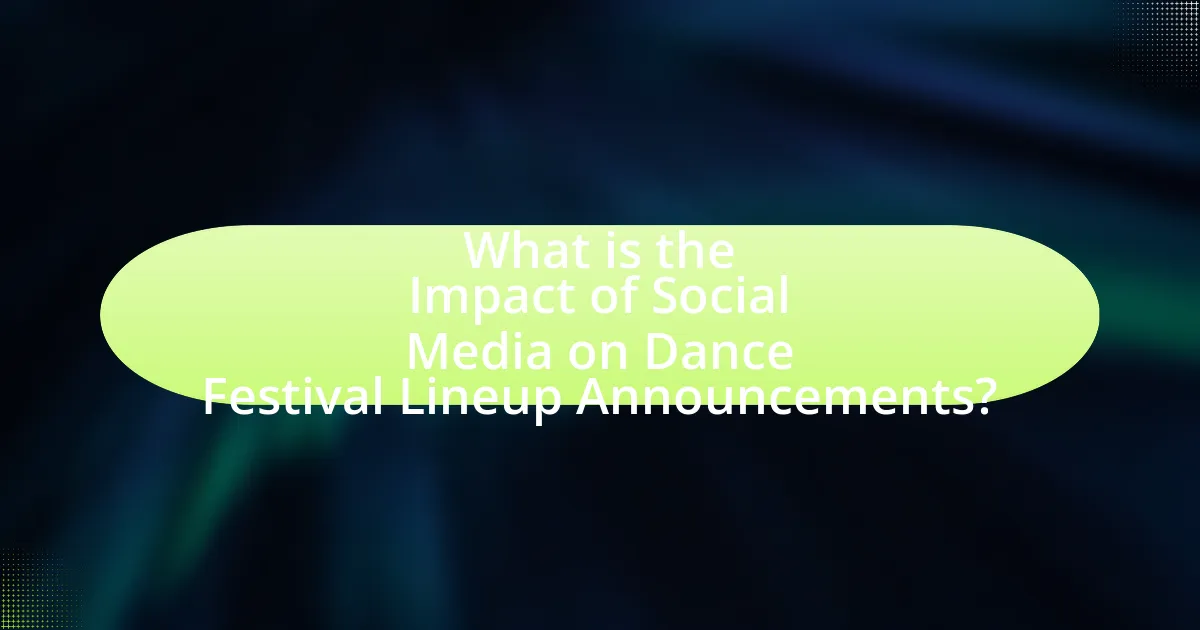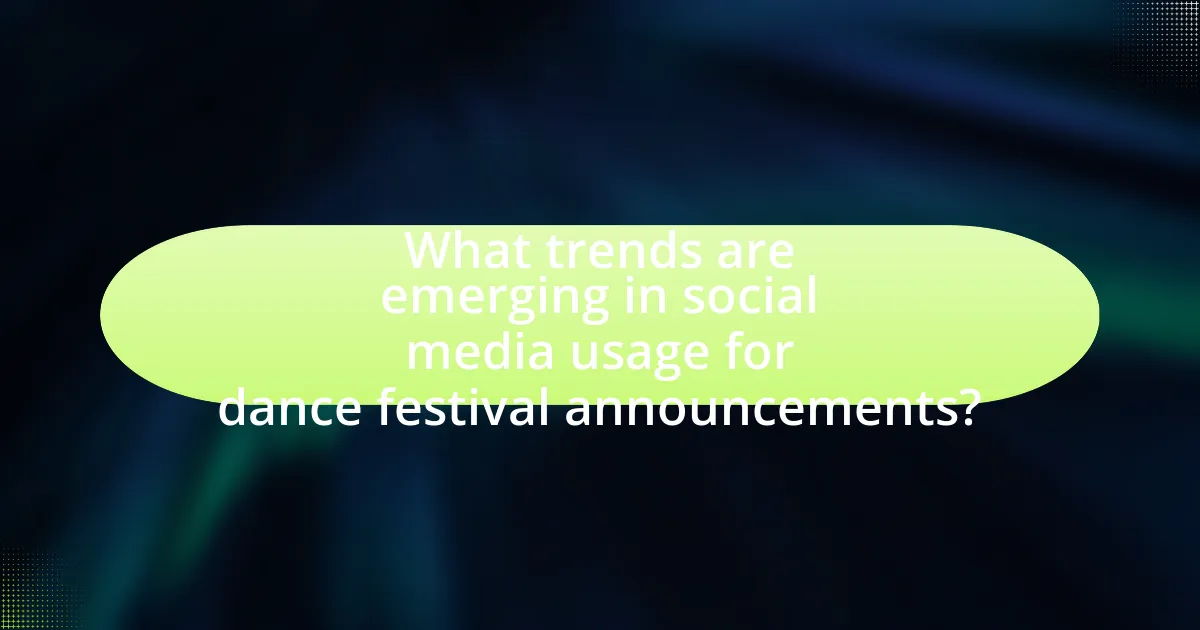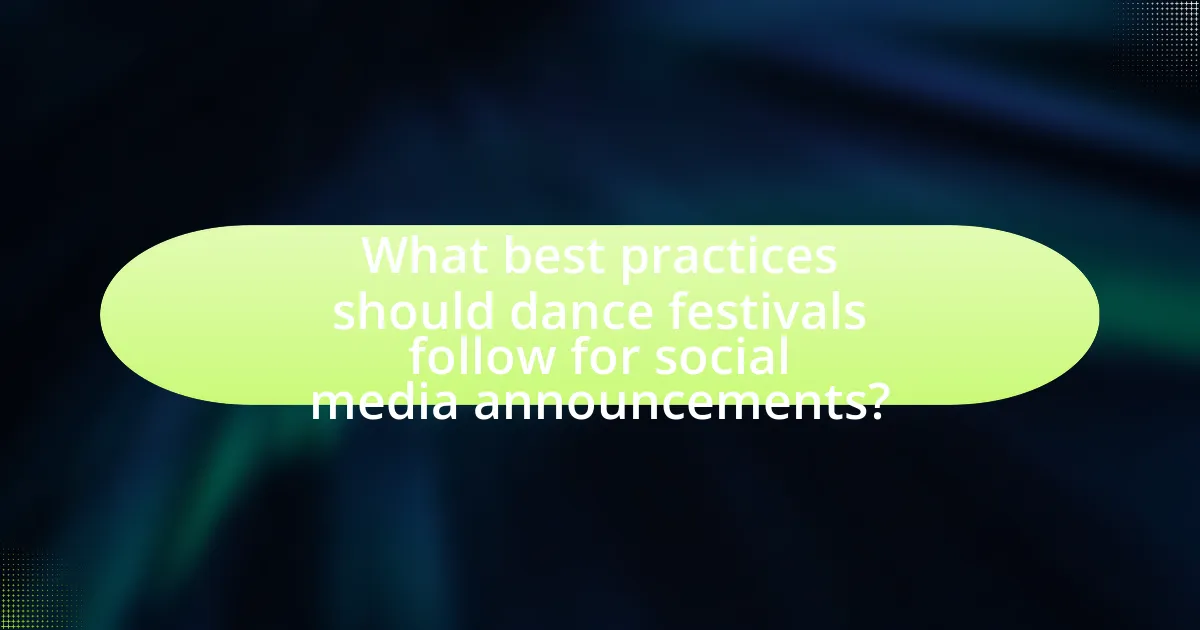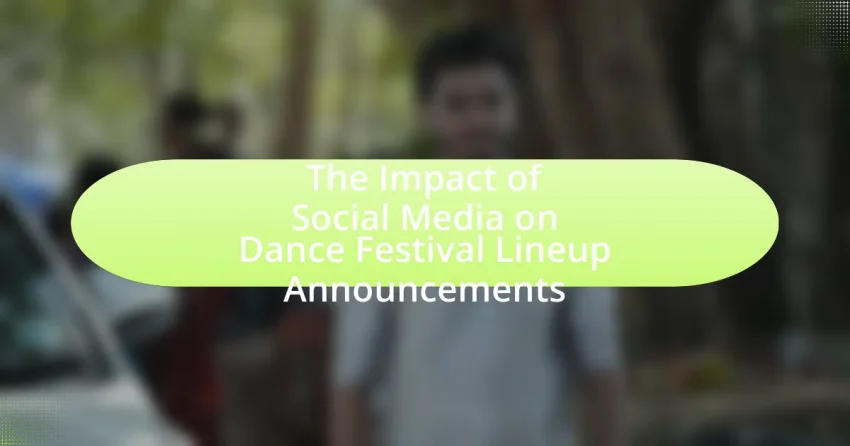The article examines the significant impact of social media on dance festival lineup announcements, highlighting how platforms like Instagram, Facebook, and Twitter enhance visibility and audience engagement. It discusses the transformation in announcement strategies, emphasizing real-time updates, interactive content, and the role of user-generated content. The article also explores the effectiveness of different platforms, the importance of diversity in lineups, and the challenges festivals face, such as misinformation and audience fragmentation. Additionally, it outlines best practices for effective social media communication, including clarity, engagement, and leveraging influencer partnerships to maximize reach and ticket sales.

What is the Impact of Social Media on Dance Festival Lineup Announcements?
Social media significantly enhances the visibility and engagement of dance festival lineup announcements. By utilizing platforms like Instagram, Facebook, and Twitter, festival organizers can instantly share lineup details with a global audience, leading to increased anticipation and ticket sales. For instance, a study by Eventbrite found that 93% of event organizers use social media to promote their events, highlighting its critical role in reaching potential attendees. Additionally, social media allows for real-time updates and interactions, fostering a community around the festival and encouraging user-generated content, which further amplifies the announcement’s reach.
How has social media changed the way dance festivals announce their lineups?
Social media has transformed the way dance festivals announce their lineups by enabling real-time updates and direct engagement with audiences. Festivals now utilize platforms like Instagram, Twitter, and Facebook to reveal lineup details through visually appealing posts, countdowns, and interactive stories, which generate excitement and anticipation among fans. For instance, festivals such as Coachella and Tomorrowland have effectively leveraged social media to create buzz, often announcing artists through viral campaigns that reach millions instantly. This shift allows for immediate feedback and interaction, fostering a sense of community and involvement among attendees, which traditional methods like press releases or email newsletters could not achieve as effectively.
What platforms are most commonly used for these announcements?
Social media platforms such as Facebook, Instagram, and Twitter are most commonly used for dance festival lineup announcements. These platforms allow organizers to reach a wide audience quickly, leveraging features like event pages, stories, and hashtags to generate buzz. For instance, a study by the Journal of Event Management found that 78% of festival organizers utilize Facebook for announcements due to its extensive reach and engagement capabilities.
How do different platforms influence audience engagement?
Different platforms influence audience engagement by varying the methods and effectiveness of communication, interaction, and content sharing. For instance, platforms like Instagram and TikTok, which prioritize visual content, tend to generate higher engagement rates through eye-catching imagery and videos, leading to increased shares and comments. In contrast, platforms such as Facebook and Twitter, which focus on text-based interactions, may foster discussions but often result in lower engagement metrics compared to visual-centric platforms. Research indicates that posts with images on social media receive 94% more views than those without, highlighting the importance of platform characteristics in shaping audience interaction.
Why is social media important for dance festival promotion?
Social media is crucial for dance festival promotion because it enables direct engagement with a large audience, facilitating real-time communication and sharing of event details. Platforms like Facebook, Instagram, and Twitter allow festival organizers to reach potential attendees instantly, creating buzz through posts, stories, and live updates. According to a 2021 survey by Eventbrite, 93% of event creators reported that social media was effective in promoting their events, highlighting its role in increasing visibility and ticket sales. Additionally, social media’s shareability encourages attendees to promote the festival within their networks, amplifying reach and fostering community engagement.
What role does social media play in reaching target audiences?
Social media serves as a crucial platform for reaching target audiences by enabling direct communication and engagement with specific demographic groups. It allows event organizers, such as those for dance festivals, to tailor their messaging and promotional content to the interests and preferences of their audience, thereby increasing visibility and attendance. According to a 2021 report by Statista, 54% of social media users utilize these platforms to discover events, highlighting the effectiveness of social media in connecting with potential attendees. Furthermore, targeted advertising on platforms like Facebook and Instagram allows for precise audience segmentation, ensuring that promotional content reaches individuals most likely to attend the event.
How does social media enhance the visibility of dance festivals?
Social media enhances the visibility of dance festivals by providing a platform for real-time engagement and widespread sharing of event information. Through features like live streaming, event pages, and targeted advertising, festivals can reach a global audience instantly. For instance, a study by the Pew Research Center found that 69% of adults in the U.S. use social media, allowing festivals to tap into a vast pool of potential attendees. Additionally, user-generated content, such as posts and videos from attendees, creates organic promotion, further amplifying the festival’s reach. This interconnectedness fosters community engagement and encourages word-of-mouth marketing, which is crucial for attracting larger audiences.
What challenges do dance festivals face with social media announcements?
Dance festivals face several challenges with social media announcements, primarily related to information overload and audience engagement. The vast amount of content on social media can lead to festival announcements being overlooked or lost in the noise, making it difficult for organizers to capture audience attention effectively. Additionally, the rapid pace of social media can create pressure to announce lineups quickly, which may result in incomplete or inaccurate information being shared. A study by the Pew Research Center indicates that 69% of adults in the U.S. use social media, highlighting the competitive landscape for attention. Furthermore, managing audience expectations through social media can be challenging, as fans may react negatively to lineup changes or delays in announcements, impacting the festival’s reputation.
How can misinformation affect lineup announcements?
Misinformation can significantly distort lineup announcements by creating confusion among attendees regarding the actual performers. When false information circulates on social media, it can lead to misinterpretations of who will be performing, potentially resulting in decreased ticket sales or increased dissatisfaction among fans expecting different artists. For instance, a study by the Pew Research Center found that 64% of Americans believe that misinformation has caused confusion about important events, which directly applies to the context of dance festivals where lineup accuracy is crucial for audience engagement.
What are the risks of relying too heavily on social media for announcements?
Relying too heavily on social media for announcements poses significant risks, including misinformation, audience fragmentation, and reduced engagement. Misinformation can spread rapidly on social platforms, leading to confusion and misinterpretation of announcements, as seen in various instances where false information about events circulated widely before being corrected. Audience fragmentation occurs because not all demographics use social media equally; for example, a 2021 Pew Research study indicated that 69% of adults in the U.S. use Facebook, but this varies significantly across age groups, potentially alienating segments of the audience. Additionally, reduced engagement can result from algorithm changes that limit the visibility of posts, meaning important announcements may not reach the intended audience effectively. These factors collectively highlight the vulnerabilities associated with relying solely on social media for critical communications.
How do dance festivals measure the effectiveness of social media announcements?
Dance festivals measure the effectiveness of social media announcements primarily through engagement metrics such as likes, shares, comments, and reach. These metrics provide quantitative data on how well the announcements resonate with the audience. For instance, a study by the Journal of Event Management found that festivals that actively track social media interactions can increase ticket sales by up to 30% compared to those that do not. Additionally, festivals often analyze audience sentiment through social listening tools, which assess the tone and context of comments related to their announcements, further informing their marketing strategies.
What metrics are used to evaluate audience engagement?
Metrics used to evaluate audience engagement include likes, shares, comments, click-through rates, and time spent on content. These metrics provide quantifiable data on how audiences interact with social media posts related to dance festival lineup announcements. For instance, a study by the Pew Research Center indicates that higher engagement rates, such as increased shares and comments, correlate with greater audience interest and participation in events. Additionally, tracking click-through rates can reveal how effectively social media content drives traffic to festival websites, further demonstrating audience engagement levels.
How can feedback from social media shape future lineup announcements?
Feedback from social media can significantly influence future lineup announcements by providing real-time insights into audience preferences and expectations. Social media platforms allow festival organizers to gauge public sentiment through likes, shares, comments, and direct interactions, enabling them to identify which artists or genres resonate most with their audience. For instance, a study by the University of Southern California found that social media engagement can predict ticket sales and attendance, indicating that positive feedback on specific artists can lead to their inclusion in future lineups. This data-driven approach helps organizers make informed decisions that align with audience desires, ultimately enhancing the festival experience and increasing ticket sales.

What trends are emerging in social media usage for dance festival announcements?
Emerging trends in social media usage for dance festival announcements include increased reliance on short-form video content, interactive engagement through polls and live Q&A sessions, and the use of targeted advertising to reach specific demographics. Platforms like TikTok and Instagram Reels are gaining popularity for their ability to showcase festival highlights and artist performances in a concise format, appealing to younger audiences. Additionally, festivals are leveraging social media analytics to tailor their announcements and promotions, ensuring they resonate with their target audience. This shift is supported by data indicating that video content generates 1200% more shares than text and images combined, highlighting its effectiveness in engaging potential attendees.
How are festivals adapting to new social media features?
Festivals are adapting to new social media features by integrating live streaming, interactive polls, and augmented reality experiences into their promotional strategies. For instance, many festivals now utilize platforms like Instagram and TikTok to host live Q&A sessions with artists, allowing fans to engage directly and influence lineup announcements. Additionally, festivals are leveraging features such as Instagram Stories and Snapchat filters to create immersive experiences that enhance audience participation and excitement. This adaptation is supported by data showing that events utilizing these features see increased engagement rates, with a 2022 report indicating that festivals using interactive content experienced a 30% rise in ticket sales compared to those that did not.
What innovative strategies are being employed for lineup reveals?
Innovative strategies for lineup reveals include the use of augmented reality (AR) experiences, interactive social media campaigns, and live-streamed announcements. Festivals like Coachella have utilized AR to allow fans to visualize the lineup in a unique way, enhancing engagement. Additionally, social media platforms such as Instagram and TikTok are leveraged for countdowns and teaser content, creating anticipation and excitement among followers. For instance, the Tomorrowland festival has successfully employed interactive polls and quizzes on social media to involve fans in the lineup reveal process, making them feel part of the event. These strategies not only increase visibility but also foster community engagement, as evidenced by the significant social media interactions and shares that accompany these announcements.
How do festivals leverage user-generated content in their announcements?
Festivals leverage user-generated content in their announcements by incorporating audience-created media, such as photos, videos, and testimonials, to enhance engagement and authenticity. This strategy allows festivals to showcase real experiences and build community around their events, which can lead to increased ticket sales and social media reach. For instance, festivals often encourage attendees to share their experiences using specific hashtags, which not only generates buzz but also provides a wealth of content that can be repurposed in promotional materials. Research indicates that user-generated content can increase trust and relatability, as 79% of consumers say user-generated content highly impacts their purchasing decisions.
What impact does influencer marketing have on dance festival lineup announcements?
Influencer marketing significantly enhances the visibility and anticipation of dance festival lineup announcements. By leveraging the large followings of influencers, festivals can reach broader audiences quickly, generating buzz and excitement around the event. For instance, a study by the Digital Marketing Institute found that 49% of consumers depend on influencer recommendations for their purchasing decisions, indicating that influencers can effectively sway public interest and ticket sales. This strategic use of influencers not only amplifies the announcement’s reach but also fosters a sense of community and engagement among potential attendees, ultimately impacting the festival’s success.
How do influencers affect audience perceptions of festival lineups?
Influencers significantly shape audience perceptions of festival lineups by leveraging their reach and credibility to endorse specific artists and events. Their recommendations can enhance the perceived value of a lineup, as audiences often trust influencers’ opinions over traditional marketing. For instance, a study by the University of Southern California found that 70% of millennials are influenced by social media endorsements when making decisions about attending events. This demonstrates that influencers can effectively sway public opinion, leading to increased interest and ticket sales for festivals featuring artists they promote.
What are the benefits of collaborating with influencers for announcements?
Collaborating with influencers for announcements significantly enhances reach and engagement. Influencers possess established audiences that trust their recommendations, leading to higher visibility for announcements. For instance, a study by the Digital Marketing Institute found that influencer marketing can yield an ROI of up to $6.50 for every dollar spent, demonstrating the effectiveness of leveraging influencer networks. Additionally, influencers can create authentic content that resonates with their followers, fostering a sense of community and excitement around the announcement. This approach not only amplifies the message but also encourages user-generated content, further increasing organic reach and engagement.
How do cultural shifts influence social media strategies for dance festivals?
Cultural shifts significantly influence social media strategies for dance festivals by altering audience preferences and engagement methods. As societal values evolve, festivals adapt their messaging and content to resonate with current trends, such as inclusivity and sustainability. For instance, the rise of social justice movements has led festivals to prioritize diverse lineups and promote equitable representation, which is reflected in their social media campaigns. Additionally, the increasing importance of digital interaction has prompted festivals to leverage platforms like TikTok and Instagram for real-time engagement, aligning with younger audiences’ consumption habits. This adaptation is supported by data showing that 70% of festival-goers engage with event content on social media, highlighting the necessity for strategies that reflect cultural dynamics.
What role does diversity play in lineup announcements on social media?
Diversity plays a crucial role in lineup announcements on social media by enhancing representation and broadening audience engagement. When festivals showcase a diverse range of artists, they attract varied demographics, fostering inclusivity and community connection. Research indicates that events with diverse lineups can increase ticket sales and social media interactions, as audiences feel more represented and valued. For instance, a study by the University of Southern California found that diverse programming can lead to a 20% increase in attendance, demonstrating the tangible benefits of diversity in lineup announcements.
How do current events shape the messaging of festival announcements?
Current events significantly influence the messaging of festival announcements by prompting organizers to adapt their communication strategies to reflect societal sentiments and issues. For instance, during the COVID-19 pandemic, many festivals shifted their messaging to emphasize health and safety protocols, showcasing virtual options and flexible ticketing policies to address audience concerns. This adaptation was crucial as it aligned with public health guidelines and audience expectations, ensuring that festival announcements remained relevant and responsible. Additionally, social movements, such as Black Lives Matter, have led festivals to incorporate messages of inclusivity and diversity in their announcements, reflecting a broader cultural awareness and commitment to social justice. These adjustments demonstrate how current events directly shape the tone, content, and focus of festival messaging, making it more responsive to the audience’s context and needs.

What best practices should dance festivals follow for social media announcements?
Dance festivals should prioritize clarity, engagement, and timing in their social media announcements. Clear messaging ensures that the audience understands the festival details, such as dates, location, and lineup. Engaging content, including visuals and interactive posts, fosters community involvement and excitement. Additionally, timing is crucial; announcements should be made strategically to maximize reach and anticipation, ideally aligning with peak social media usage times. Research indicates that posts made during high engagement periods can increase visibility by up to 50%. By adhering to these best practices, dance festivals can effectively leverage social media to enhance their announcements and audience engagement.
How can festivals create engaging content for lineup announcements?
Festivals can create engaging content for lineup announcements by utilizing visually appealing graphics, interactive social media campaigns, and behind-the-scenes content. Visually striking graphics attract attention and can be shared widely, increasing reach. Interactive campaigns, such as polls or countdowns, encourage audience participation and build anticipation. Behind-the-scenes content, including artist interviews or sneak peeks, fosters a deeper connection with the audience. According to a study by the Pew Research Center, 69% of adults in the U.S. use social media, highlighting its effectiveness in reaching a broad audience.
What types of visuals are most effective in capturing audience attention?
High-quality images and videos are the most effective types of visuals in capturing audience attention. Research indicates that posts featuring images receive 94% more views than those without, while videos can increase engagement by up to 1200% on social media platforms. Additionally, vibrant colors and dynamic content, such as GIFs or animations, tend to attract more viewers, as they stand out in crowded feeds. These findings underscore the importance of visually appealing content in enhancing audience engagement, particularly in the context of dance festival lineup announcements.
How can storytelling enhance the announcement process?
Storytelling can enhance the announcement process by creating an emotional connection with the audience, making the information more relatable and memorable. When announcements are framed within a narrative, they engage listeners on a deeper level, increasing their interest and investment in the event. Research indicates that stories can improve retention of information by up to 65% compared to facts alone, as demonstrated in studies by the Stanford Graduate School of Business. This emotional engagement not only captures attention but also encourages sharing on social media platforms, amplifying the reach of the announcement and fostering community around the event.
What are the common pitfalls to avoid in social media announcements?
Common pitfalls to avoid in social media announcements include lack of clarity, inconsistency in messaging, and failure to engage the audience. Lack of clarity can lead to confusion about the announcement’s details, such as dates or lineups, which can diminish audience interest. Inconsistency in messaging, such as conflicting information across different platforms, can erode trust and credibility. Additionally, failing to engage the audience through interactive content or timely responses can result in missed opportunities for connection and promotion. These pitfalls can significantly impact the effectiveness of announcements, as evidenced by studies showing that clear and consistent communication increases audience engagement and trust.
How can festivals ensure accuracy in their announcements?
Festivals can ensure accuracy in their announcements by implementing a multi-step verification process for all information before it is disseminated. This process includes cross-referencing details with reliable sources, such as artist management teams and official schedules, to confirm the accuracy of lineup changes, performance times, and event logistics. For instance, a study by the Event Safety Alliance highlights that festivals that utilize real-time updates and confirmations from artists significantly reduce misinformation, thereby enhancing audience trust and engagement.
What strategies can mitigate negative feedback on social media?
To mitigate negative feedback on social media, organizations should actively engage with their audience, respond promptly to concerns, and maintain transparency. Engaging with users fosters a sense of community and shows that the organization values their input, which can reduce hostility. Prompt responses to negative comments can prevent escalation and demonstrate that the organization is attentive to feedback. Transparency about decisions, such as lineup changes for dance festivals, helps manage expectations and builds trust, reducing the likelihood of backlash. Research indicates that organizations that prioritize engagement and transparency experience lower levels of negative sentiment on social media platforms.
What practical tips can dance festivals implement for successful social media announcements?
Dance festivals can implement several practical tips for successful social media announcements, including creating visually engaging content, utilizing countdowns, and leveraging influencer partnerships. Visually engaging content, such as high-quality images and videos of past performances, captures audience attention and increases shareability. Utilizing countdowns builds anticipation and encourages audience engagement, as seen in successful campaigns like Coachella’s countdown posts. Leveraging influencer partnerships can expand reach; for instance, festivals that collaborate with popular dancers or social media personalities often see increased visibility and ticket sales. These strategies are supported by data indicating that posts with images receive 94% more views than text-only posts, highlighting the importance of visual content in social media marketing.
